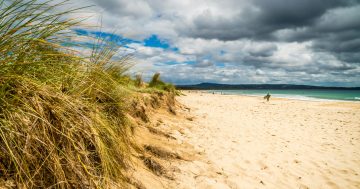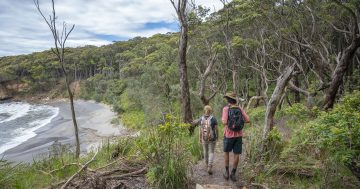
Drowning fatalities could be decreased if more emphasis is placed on swimming lessons and water safety. Photo: SLS NSW.
Canberrans’ love affair with the NSW South Coast has continued unabated this summer with the beach lifestyle particularly attractive.
It’s a chance to recharge the batteries after another year of work.
The allure of the coast extends to swimming at the many kilometres of beaches, most of which are unpatrolled.
Judging by what I have seen over the summer, many people are prepared to take the risk of swimming away from areas patrolled by surf lifesavers.
For landlocked Canberrans, it’s a huge risk to take if their annual pilgrimage to the South Coast is their only exposure to the surf each year.
There are additional factors at play emphasising the dangers of a summer surf holiday, including the COVID disruption to swimming lessons, which has severely impacted the swimming ability of younger children.
To amplify how deadly the surf can be, a report released last September following research by the Royal Life Saving Australia and Surf Life Saving Australia makes for sobering reading.
The Royal Life Saving National Drowning Report 2022 revealed that in the previous 12 months, there were 339 drowning fatalities. This was the highest number of deaths by drowning in 25 years.
Forty-three were flood-related while 141 were on the coast.
Men accounted for most drowning fatalities, with contributing factors including alcohol, a penchant for risky behaviour and over-estimating their swimming ability.
Twenty-six per cent of drowning fatalities involved people over 65.
While it is sobering to read, it should also act as a wake-up call.
The problem isn’t necessarily rectified by having more patrolled beaches. Swimming between the flags should be a given, but there also needs to be a focus on teaching young people how to swim.
I suggest that children should be able to demonstrate that they can competently swim a lap of a 50-metre pool by the time they have finished primary school. Although not a fail-safe response, as a pre-requisite to safer swimming, it would surely help.
National statistics reveal that around 40 per cent of kids don’t have that ability, with the lack of organised swimming lessons being a significant factor.
Living in an inland city is no excuse for ignorance about the dangers of ocean swimming. There should be a focus on identifying the dangers of swimming in the surf as part of swimming lessons so that young people of appropriate age can identify dangers such as a rip before entering the water.
Each year we see campaigns on television to build awareness of the risk associated with waterways, but each year we hear of the tragic loss of life through drowning. Drowning fatalities will continue to shock us while teaching people how to swim and water safety is not a national priority.















